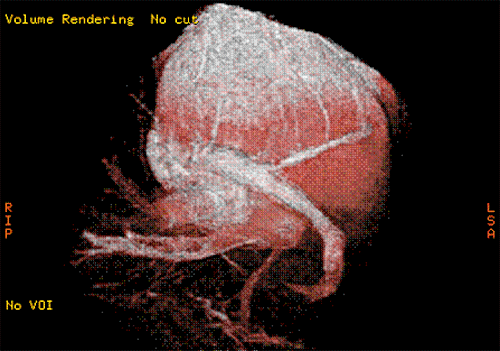Oxygen-sensitive MR imaging
Yuesong Yang, MD, PhD
Cardiovascular diseases are the leading cause of death in developed countries. Global left ventricular (LV) function evaluation is a critical part of the management of patients with cardiovascular diseases. A comprehensive global LV function evaluation should include an accurate measurement of both LV systolic and diastolic function. However, in clinical practice, left ventricular ejection fraction (LVEF), the most frequently measured parameter, reflects only the systolic function. From a physiological perspective, myocardial oxygen consumption (MVO2), a measure reflecting the overall myocardial oxidative metabolism and the total energy use of the heart, may be a better parameter than LVEF in the evaluation of LV dysfunction. The successful determination of MVO2 may allow for an easier estimation of cardiac efficiency, defined as stroke work/MVO2, which might be one of the best parameters to describe the overall LV function. This is especially true for diastolic LV dysfunction that is commonly seen in patients with hypertension and hypertrophic cardiomyopathy, where LVEF usually does not decrease even though the MVO2 and cardiac efficiency might be altered.
Many noninvasive techniques have been developed to measure MVO2 but with limited success. Cardiac magnetic resonance imaging using tissue T2 quantification and the BOLD (blood oxygen level-dependent) effect has been investigated for assessing the regional differences of oxygen consumption in the heart. A global LV function and metabolism evaluation might play a more important role in the clinical management of patients with diffuse cardiovascular diseases. Such a global LV MVO2 measurement has not been realized using MRI before. Because the CS flow represents approximately 96% of the venous drainage of the LV, the technique based on Fick's law that requires direct catheterization of the CS to acquire the arterial and venous oxygen saturation differences and flow has become the gold standard for global LV MVO2 measurement. This direct method, however, is not widely used due to its invasiveness. Our study investigates MRI techniques that combine coronary sinus oximetry, cine phase contrast (PC) flow measurements and LV mass calculations to get global MVO2 noninvasively.

3-D high-resolution MRA nicely demonstrated the coronary sinus including the draining branches in a domestic pig.
References
- Yang Y, Foltz W, Graham J, Detsky JS, Dick AJ, Wright GA. MRI Evaluation of Microvascular Obstruction in Experimental Reperfused Acute Myocardial Infarction Using a T1 and T2 Preparation Pulse Sequence. J Magn Reson Imaging 2007; 26: 1486-1492.
- Yang Y, Graham J, Foltz W, Dick AJ, Wright GA. Persistent microvascular obstruction and left ventricular remodeling in reperfused acute myocardial infarction: an experimental short-time course study using magnetic resonance imaging. J Cardiovasc Magn Reson 2007; 9: 191-192.
- Yang Y, Merchant N, Foltz W, Wright GA. Quantitative measurement of whole body oxygen consumption using magnetic resonance imaging: a volunteer study. Proc. Intl. Soc. Mag. Reson. Med.13 (2005), P1690, Miami.
- Yang Y, Foltz W, Hong J, Stainsby J, Dharmakumar R, Merchant N, Wright GA. MR feasibility study of global left ventricular myocardial oxygen consumption in normal volunteers: preliminary results. Proc. Intl. Soc. Mag. Reson. Med. 12 (2004), p317, Kyoto.
- Yang Y, Merchant N, Provost YL, Konen E, Wright GA. Mural thrombus in post-infarction left ventricular aneurysm: a varied MR appearance. 89th Scientific Assembly and Annual Meeting Program, RSNA'03, p252. (Research Fellow Trainee Prize).


